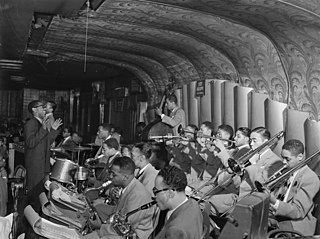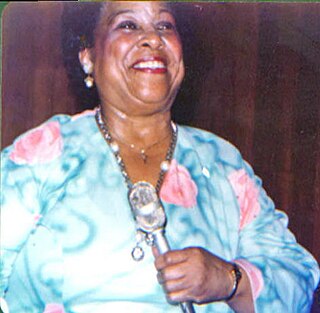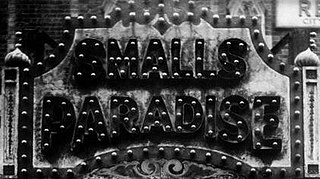Related Research Articles

Ferdinand Joseph LaMothe, known professionally as Jelly Roll Morton, was an American ragtime and jazz pianist, bandleader, and composer of Louisiana Creole descent. Morton was jazz's first arranger, proving that a genre rooted in improvisation could retain its essential characteristics when notated. His composition "Jelly Roll Blues", published in 1915, was one of the first published jazz compositions. He also claimed to have invented the genre.

The Savoy Ballroom was a large ballroom for music and public dancing located at 596 Lenox Avenue, between 140th and 141st Streets in the Harlem neighborhood of Manhattan, New York City. Lenox Avenue was the main thoroughfare through upper Harlem. Poet Langston Hughes calls it the "Heartbeat of Harlem" in Juke Box Love Song, and he set his work "Lenox Avenue: Midnight" on the legendary street. The Savoy was one of many Harlem hot spots along Lenox, but it was the one to be called the "World's Finest Ballroom". It was in operation from March 12, 1926, to July 10, 1958, and as Barbara Englebrecht writes in her article "Swinging at the Savoy", it was "a building, a geographic place, a ballroom, and the 'soul' of a neighborhood". It was opened and owned by white entrepreneur Jay Faggen and Jewish businessman Moe Gale. It was managed by African-American businessman and civic leader Charles Buchanan. Buchanan, who was born in the British West Indies, sought to run a "luxury ballroom to accommodate the many thousands who wished to dance in an atmosphere of tasteful refinement, rather than in the small stuffy halls and the foul smelling, smoke laden cellar nightclubs ..."

Earl Kenneth Hines, also known as Earl "Fatha" Hines, was an American jazz pianist and bandleader. He was one of the most influential figures in the development of jazz piano and, according to one source, "one of a small number of pianists whose playing shaped the history of jazz".

Helen Humes was an American singer. Humes was a teenage blues singer, a vocalist with Count Basie's band, a saucy R&B diva, and a mature interpreter of the classic popular song.
Western swing is a subgenre of American country music that originated in the late 1920s in the West and South among the region's Western string bands. It is dance music, often with an up-tempo beat, which attracted huge crowds to dance halls and clubs in Texas, Oklahoma and California during the 1930s and 1940s until a federal war-time nightclub tax in 1944 contributed to the genre's decline.
The Memphis Jug Band was an American musical group active from the mid-1920s to the late-1950s. The band featured harmonica, kazoo, fiddle and mandolin or banjolin, backed by guitar, piano, washboard, washtub bass and jug. They played slow blues, pop songs, humorous songs and upbeat dance numbers with jazz and string band flavors. The band made the first commercial recordings in Memphis, Tennessee, and recorded more sides than any other prewar jug band.

Eva Taylor was an American blues singer and stage actress.

Leonard Geoffrey Feather was a British-born jazz pianist, composer, and producer, who was best known for his music journalism and other writing.

"The Way You Look To-night" is a song from the film Swing Time that was performed by Fred Astaire and composed by Jerome Kern with lyrics written by Dorothy Fields. It won the Academy Award for Best Original Song in 1936. Fields remarked, "The first time Jerry played that melody for me I went out and started to cry. The release absolutely killed me. I couldn't stop, it was so beautiful."
Stanley Frank Dance was a British jazz writer, business manager, record producer, and historian of the Swing era. He was personally close to Duke Ellington over a long period, as well as many other musicians; because of this friendship Dance was in a position to write "official" biographies. Over his career, his priority was advocating for the music of black ensembles performing sophisticated arrangements, based on Swing-era dance music.

Sara Martin was an American blues singer, in her time one of the most popular of the classic blues singers. She was billed as "The Famous Moanin' Mama" and "The Colored Sophie Tucker". She made many recordings, including a few under the names Margaret Johnson and Sally Roberts.
The Hoofers Club was an African-American entertainment establishment and dancers' club hangout in Harlem, New York, that ran from the early 1920s until the early 1940s. It was founded and managed by Lonnie Hicks (1882–1953), an Atlanta-born ragtime pianist.

Perry Bradford was an American composer, songwriter, and vaudeville performer. His most notable songs included "Crazy Blues," "That Thing Called Love," and "You Can't Keep A Good Man Down." He was nicknamed "Mule" because of his stubbornness, and he is credited with finally persuading Okeh Records to work with Mamie Smith leading to her historic blues recording in 1920.
Monette Moore was an American jazz and classic female blues singer.
In music, the term swing has two main uses. Colloquially, it is used to describe the propulsive quality or "feel" of a rhythm, especially when the music prompts a visceral response such as foot-tapping or head-nodding. This sense can also be called "groove".
Connie's Inn was a Harlem, New York City, black and tan nightclub established in 1923 by Connie Immerman (né Conrad Immerman; 1893–1967) in partnership with two of his brothers, George (1884–1944) and Louie Immerman (1882–1955).
Ronald Maxwell Jones was a British jazz author, radio host and journalist.

Smalls Paradise, was a nightclub in the Harlem neighborhood of Manhattan in New York City. Located in the basement of 2294 Adam Clayton Powell Jr. Boulevard at 134th Street, it opened in 1925 and was owned by Ed Smalls (né Edwin Alexander Smalls; 1882–1976). At the time of the Harlem Renaissance, Smalls Paradise was the only one of the well-known Harlem night clubs to be owned by an African-American and integrated. Other major Harlem night clubs admitted only white patrons unless the person was an African-American celebrity.
The Golden Gate Ballroom, originally named the "State Palace Ballroom", was a luxurious ballroom located at the intersection of Lenox Avenue and 142nd Street in Harlem in New York City. It was allegedly the largest public auditorium in Harlem, with 25,000 square feet and a capacity of about 5,000 people on the dance floor in addition to several thousand spectators.
References
- ↑ Ed Kirkeby. Ain't Misbehavin': The Story of Fats Waller, New York: Dodd, Mead (1966), reprint Da Capo Press, p. 149, ISBN 0-306-80015-2
- ↑ Whitney Balliett. American Singers: Twenty-Seven Portraits in Song, Jackson: University Press of Mississippi (1988, 2005), p. 24
- ↑ John Chilton. Who's Who of Jazz: Storyville to Swing Street, Da Capo Press (1972, 1985), p. 342, ISBN 0-306-76271-4
- ↑ Stanley Dance, The World of Swing, Da Capo Press, 2nd edition (2001), p. 58, ISBN 0-306-81016-6
- ↑ Garvin Bushell as told to Mark Tucker. Jazz from the Beginning, New York: Da Capo Press (1988, 1998), p. 77, ISBN 0-306-80848-X
- ↑ Stanley Dance. The World of Duke Ellington, Da Capo Press (2000), p. 59, ISBN 0-306-81015-8